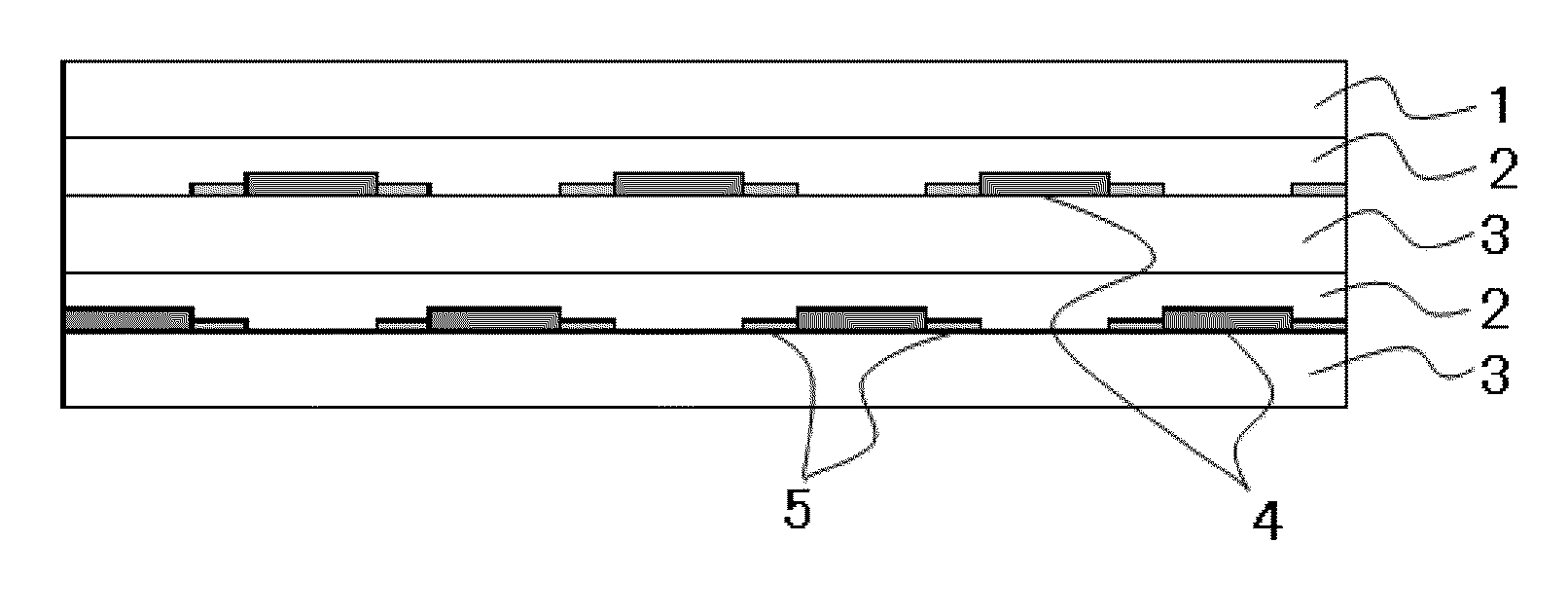Substrate having transparent conductive layer, method for producing same, transparent conductive film laminate for touch panel, and touch panel
a technology conductive layer, which is applied in the direction of conductive layer on insulating support, instruments, transportation and packaging, etc., can solve the problems of difficult production process, low resistance and high transmittance of transparent conductive film, and easy visualization of differences in haze due to fibrous conductive substance, etc., to achieve easy visual recognition, easy to recognize, and easy to distinguish optical properties
- Summary
- Abstract
- Description
- Claims
- Application Information
AI Technical Summary
Benefits of technology
Problems solved by technology
Method used
Image
Examples
example 1
Synthesis of Silver Nanowires
[0236]Silver nanowires are synthesized by a method in which a polyol is used, the method being described in Y. Sun, B. Gates, B. Mayers, & Y. Xia, “Crystalline silver nanowires by soft solution processing” Nano letters, (2002), 2(2) 165-168, then by dissolving silver sulfate in ethylene glycol in the presence of polyvinylpyrrolidone (PVP), and reducing the silver sulfate. Specifically, nanowires used in the present invention were synthesized by the amended polyol method described in U.S. Provisional Patent Application No. 60 / 815,627 applied by Cambrios Technologies Corporation.
[Formation of Transparent Conductive Layer]
[0237]An aqueous dispersion (ClearOhm™, Ink-A AQ, manufactured by Cambrios Technologies Corporation) containing, as metal nanowires to form a transparent conductive layer, 0.5% w / v silver nanowires synthesized by the foregoing method and having a minor axis diameter of about 70 nm to 80 nm and an aspect ratio of 100 or more in an aqueous m...
example 2
[0249]Unlike Example 1, as a dummy pattern configured to improve viewability, conductive dummy pattern regions, in which dot-like regions not covered with the transparent conductive films and having a diameter of 30 μm were arranged with a pitch of 73 μm, were formed in the linking portions which were formed of the transparent conductive films and which connected the electrode portions to each other. Furthermore, insulating dummy pattern regions, in which dot-like regions covered with the transparent conductive films and having a diameter of 30 μm were arranged with a pitch of 73 μm, were formed in the gap portions where no transparent conductive film is present when the X electrodes were orthogonally superimposed on the Y electrodes.
[0250]The former linking portions that connected the electrode portions to each other were conductive and had conductivity comparable to that of the electrode portions. The haze value of the linking portions was 70% of that of the electrode line portion...
PUM
 Login to View More
Login to View More Abstract
Description
Claims
Application Information
 Login to View More
Login to View More - R&D
- Intellectual Property
- Life Sciences
- Materials
- Tech Scout
- Unparalleled Data Quality
- Higher Quality Content
- 60% Fewer Hallucinations
Browse by: Latest US Patents, China's latest patents, Technical Efficacy Thesaurus, Application Domain, Technology Topic, Popular Technical Reports.
© 2025 PatSnap. All rights reserved.Legal|Privacy policy|Modern Slavery Act Transparency Statement|Sitemap|About US| Contact US: help@patsnap.com



